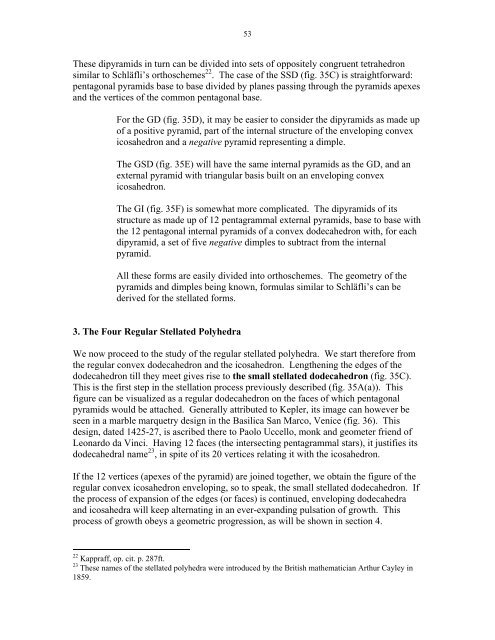Ad Quadratum Construction and Study of the Regular Polyhedra
Ad Quadratum Construction and Study of the Regular Polyhedra
Ad Quadratum Construction and Study of the Regular Polyhedra
Create successful ePaper yourself
Turn your PDF publications into a flip-book with our unique Google optimized e-Paper software.
53<br />
These dipyramids in turn can be divided into sets <strong>of</strong> oppositely congruent tetrahedron<br />
similar to Schläfli’s orthoschemes 22 . The case <strong>of</strong> <strong>the</strong> SSD (fig. 35C) is straightforward:<br />
pentagonal pyramids base to base divided by planes passing through <strong>the</strong> pyramids apexes<br />
<strong>and</strong> <strong>the</strong> vertices <strong>of</strong> <strong>the</strong> common pentagonal base.<br />
For <strong>the</strong> GD (fig. 35D), it may be easier to consider <strong>the</strong> dipyramids as made up<br />
<strong>of</strong> a positive pyramid, part <strong>of</strong> <strong>the</strong> internal structure <strong>of</strong> <strong>the</strong> enveloping convex<br />
icosahedron <strong>and</strong> a negative pyramid representing a dimple.<br />
The GSD (fig. 35E) will have <strong>the</strong> same internal pyramids as <strong>the</strong> GD, <strong>and</strong> an<br />
external pyramid with triangular basis built on an enveloping convex<br />
icosahedron.<br />
The GI (fig. 35F) is somewhat more complicated. The dipyramids <strong>of</strong> its<br />
structure as made up <strong>of</strong> 12 pentagrammal external pyramids, base to base with<br />
<strong>the</strong> 12 pentagonal internal pyramids <strong>of</strong> a convex dodecahedron with, for each<br />
dipyramid, a set <strong>of</strong> five negative dimples to subtract from <strong>the</strong> internal<br />
pyramid.<br />
All <strong>the</strong>se forms are easily divided into orthoschemes. The geometry <strong>of</strong> <strong>the</strong><br />
pyramids <strong>and</strong> dimples being known, formulas similar to Schläfli’s can be<br />
derived for <strong>the</strong> stellated forms.<br />
3. The Four <strong>Regular</strong> Stellated <strong>Polyhedra</strong><br />
We now proceed to <strong>the</strong> study <strong>of</strong> <strong>the</strong> regular stellated polyhedra. We start <strong>the</strong>refore from<br />
<strong>the</strong> regular convex dodecahedron <strong>and</strong> <strong>the</strong> icosahedron. Leng<strong>the</strong>ning <strong>the</strong> edges <strong>of</strong> <strong>the</strong><br />
dodecahedron till <strong>the</strong>y meet gives rise to <strong>the</strong> small stellated dodecahedron (fig. 35C).<br />
This is <strong>the</strong> first step in <strong>the</strong> stellation process previously described (fig. 35A(a)). This<br />
figure can be visualized as a regular dodecahedron on <strong>the</strong> faces <strong>of</strong> which pentagonal<br />
pyramids would be attached. Generally attributed to Kepler, its image can however be<br />
seen in a marble marquetry design in <strong>the</strong> Basilica San Marco, Venice (fig. 36). This<br />
design, dated 1425-27, is ascribed <strong>the</strong>re to Paolo Uccello, monk <strong>and</strong> geometer friend <strong>of</strong><br />
Leonardo da Vinci. Having 12 faces (<strong>the</strong> intersecting pentagrammal stars), it justifies its<br />
dodecahedral name 23 , in spite <strong>of</strong> its 20 vertices relating it with <strong>the</strong> icosahedron.<br />
If <strong>the</strong> 12 vertices (apexes <strong>of</strong> <strong>the</strong> pyramid) are joined toge<strong>the</strong>r, we obtain <strong>the</strong> figure <strong>of</strong> <strong>the</strong><br />
regular convex icosahedron enveloping, so to speak, <strong>the</strong> small stellated dodecahedron. If<br />
<strong>the</strong> process <strong>of</strong> expansion <strong>of</strong> <strong>the</strong> edges (or faces) is continued, enveloping dodecahedra<br />
<strong>and</strong> icosahedra will keep alternating in an ever-exp<strong>and</strong>ing pulsation <strong>of</strong> growth. This<br />
process <strong>of</strong> growth obeys a geometric progression, as will be shown in section 4.<br />
22<br />
Kappraff, op. cit. p. 287ft.<br />
23<br />
These names <strong>of</strong> <strong>the</strong> stellated polyhedra were introduced by <strong>the</strong> British ma<strong>the</strong>matician Arthur Cayley in<br />
1859.




